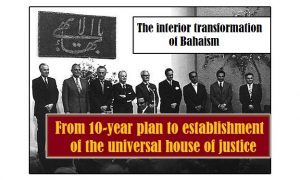The interior and organizational transformations of Bahaism can be explained as follows:
آنچه در ادامه می خوانید
I) The 10-year plan of organ organization: The 10-year plan was the Bahaism operational plan to proceed its aims in Iran to expand this cult across the world announced by Shogi Effendi and executed since 1332 S.H.
The remarkable note about this plan was planned and became operational after the establishment of Zionistic regime and its bilateral relationship with the Iranian government and Bahaism cult and drove faster in execution by British-American coup of Mordad 28.
The programs of Pahlavi regime were performing based on this plan such as the land reform plan and Eyalati and Velayati associations bill in which the heavenly books were mentioned instead of the holy Quran in order for Bahaism to be recognized formally and for its dominance to be stabilized.
This plan was started Since 1332 for 10 years and wasn’t stopped with Shogi Effendi’s death in 1336 and continued to the year 1342 S.H.
“The 10-year plan included 28 detailed aims focused on the increase of the numbers of the followers of Bahaism across the world, reduplication of the numbers of regions which were under the shadow of the divine faith and increase in numbers of the words by which the faith works have been translated or printed or are being printed. Reduplication of the numbers of dawning places of the Mention of God in the Baha’i community, purchasing the holy Baha’i places in Iran and the increase in the numbers of the spiritual and central assemblies; that is, quadruple. Nevertheless, the most important aim of the plan may be the establishment of the universal house of justice in Israel (the holy land) which was to be established after the foundation of the Baha’i court in this land and the election of religious law board members of the divine faith.” [1]
Based on this plan, the Baha’i proselytizers were sent to various parts of the world and the Baha’i texts were translated to other languages and the population of the world increased. According to Dennis McEoin, the master of New Castle university, England in Iranica encyclopedia:
“Bahaism grew slowly during the years 1928-1952 A.D.; but its speed increased since 1952 A.D./1331 S.H. and this faith was planned and organized started since 10-year plan of Shogi Effendi.”[۲]
After the universal 10-year plan, the Iranian Baha’is executed the 9-year plan (1343-1352) and 5-year plan (1353-1358), too. The 7-year plan of the Baha’is of Iran (1358-1365) was stopped due to the victory of the Islamic Revolution of Iran.
II) The establishment of the universal house of justice: One of the aims of the 10-year program was the establishment of the universal house of justice which must take over the aims of the cult, direct supervise and pursue the aims of the cult alongside with the guardian of the faith. The universal house of justice is the center for managing, directing and supervising the Baha’is having party and masonry like structure.
For the first time, Hussein Ali Nouri used the title of the universal hour of justice in the book Aghdas. According to him, the formation of the universal house of justice is necessary in every city or locality in which at least nine Baha’is are resided.
Travelling to European countries and the American ones and being imitating the Western system pertaining to a party, Abbas Effendi defined the organizational domain of the universal house of justice as more expanded than what had predicted by Baha.
Shoghi Effendi considered settling Bahaism as being dependent on establishing the universal house of justice and the purpose of its establishment as establishing the universal government of Bahaism. Of course, Iran has been the cradle of God’s faith as the top aim of this cult for establishing the government. However, this newly established organization faced the crisis of validity and legitimacy because according to Bahaism leaders’ order, the managing of Baha’is community is taken over by the guardian of the faith and the universal house of justice organization and the guardian of the faith is on the top, but after Shoghi’s death and the lack of introducing the next guardian of the faith, the main pillar of Bahaism was omitted and the universal house justice became the one which could do everything all.
The organizational process of this colonial cult continues and the universal house of justice is the main center and the restrictive one of each kind of decision making for this organization.
Keep in touch with us: bahaismiran85@gmail.com
[۱] Leila Chaman Khah, Baha’ism and Pahlavi regime, Tehran, the Contemporary look, 1391 S.H., p. 102.
[۲] Mojan Mo’men, Iranica.






